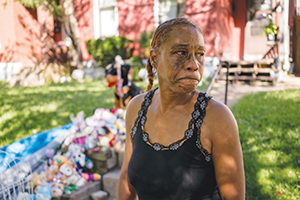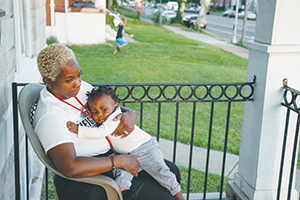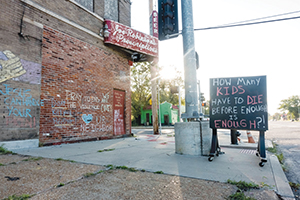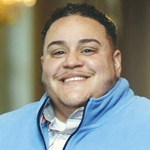By LISA EISENHAUER
ST. LOUIS — One of the young victims Melik Coffey has worked with in recent months was shot as he was walking to a bus stop.
The bullet caused internal injuries so severe that the teenager spent weeks at SSM Health Cardinal Glennon Children's Hospital in St. Louis, where Coffey met him. Coffey is a licensed clinical social worker and a key player in a new program the teenager enrolled in that is focused on changing the life trajectory for the hundreds of children and young adults from St. Louis and St. Louis County who are shot, stabbed, beaten, brutally bullied or otherwise traumatized every year. So far this year, city police reports alone show 23 homicide victims age 19 or younger.

Tracy Wafford stands next to a memorial for her 3-year-old granddaughter, Kennedi Powell, outside the home in south St. Louis where the child was killed in June in a drive-by shooting. Another bullet injured a 6-year-old neighbor. Kennedi is one of the 23 homicide victims age 19 or younger in the city so far this year. Whitney Curtis
The program Coffey is part of, called Life Outside of Violence, is a collaboration of the four hospitals in St. Louis with Level 1 trauma designation: SSM Health Saint Louis University Hospital and the system's adjacent Cardinal Glennon Children's Hospital,and BJC HealthCare's Barnes–Jewish Hospital and neighboring St. Louis Children's Hospital. The BJC and SSM Health nonprofit academic medical centers are located within about a 2-mile radius. All four have treated an increased number of young victims of violence in recent years.
In the case of the teenager shot at the bus stop, Coffey helped him meet his goal of returning to work and linked him with tutoring so he could catch up in school and graduate with his class.

Chante Bass watches her children and grandchildren play as she holds her 10-month-old grandson Lamarco Sharp Jr. The family lives in north St. Louis, which has long been plagued by gun violence. Whitney Curtis

Pleas for an end to violence are on the wall of an abandoned corner store and a sign out front in north St. Louis. Workers at SSM Health Saint Louis University Hospital and SSM Health Cardinal Glennon Children’s Hospital say both hospitals are seeing more young violence victims this year than in recent years. Whitney Curtis
The LOV program is using grant funding from the Missouri Foundation for Health to cover the salaries of Coffey and four other social workers who offer case management, therapy, counseling and mentoring services for any victim of gunshot, stabbing or assault age 8-24 who comes into the hospitals' emergency rooms for care and lives in St. Louis city or county. In the city of St. Louis alone, the police department logged 698 incidents of aggravated assault with 1,080 victims age 24 or younger from January through September of this year.
In the most serious cases undertaken by LOV social workers, the victims have suffered near-fatal gunshot wounds. But in some cases, the assault victims have no visible marks. As long as the victim is hurt in a non-domestic incident, has sought care in one of the hospitals' ERs and meets the program's residency requirement, that person is eligible to enroll in LOV.
About these photos
The news photographs that accompany this story were taken by St. Louis-based freelance photographer Whitney Curtis to illustrate a news report on the fatal shootings of black children in St. Louis that was published by The Guardian in October. At the time The Guardian's report was published, 13 black children age 16 or younger had been fatally shot in the city since the beginning of the year.
The social workers meet with their clients for six months to a year, until the young person is in a stable place both physically and mentally. The goal is to keep the victims from being caught in a cycle of violence and retaliation claiming more, and often repeat victims.
Chronic trauma
Kateri Chapman-Kramer, LOV's project coordinator, says the anti-violence program, which started in August 2018, is modeled on a program that had been underway at St. Louis Children's Hospital since 2012.

Coffey
Similar programs elsewhere in the nation have existed since the 1990s. Many were started in the wake of a study called "Urban Trauma: A Chronic Recurrent Disease," published in the July 1989 Journal of Trauma: Injury, Infection and Critical Care. Researchers found that of the 501 survivors of violent trauma treated at one trauma center over a two-year period, 20 percent were dead and 44 percent returned with a violent injury within five years.
Measuring impact of intervention
What sets LOV apart from the other violence intervention programs, those overseeing it say, is the coordination between the four hospitals. (LOV is formally called the St. Louis Area Hospital-Based Violence Intervention Program.) They are sharing patient information and related data to determine if the interventions work to prevent revictimization. "For the hospitals that are a part of this partnership, it was very clear they were often seeing the same patients come in for repeat injuries and so it made sense to join efforts to address this," Chapman-Kramer says.

Chapman-Kramer
In addition to the four hospitals, Washington University in St. Louis, Saint Louis University and the University of Missouri – St. Louis are partners in the project. They will conduct related research and evaluation, such as tracking the patients' long-term outcomes.
Rethinking choices
Stephanie Harris, a social worker who is part of LOV, says the project tries to redirect young violence victims who might consider their only or best response to be striking back. "It helps people see their options so they can make the right choices," says Harris, who is based at SLU hospital.
Most of the violence victims referred to Harris are black or Hispanic young men in their late teens or early 20s who were shot. They include a young man who was in a shootout and others who were bystanders when gunfire broke out.
She and the other social workers use a variety of therapeutic techniques to help clients, including:
- Trauma-informed counseling where clients talk about issues around their injuries and work through their feelings and emotions.
- Dialectical behavior therapy, a type of cognitive therapy with the goal of helping a client gain better control of emotions, cope with stress and improve relationships.
- Motivational interviewing to encourage a client to undertake specific tasks such as to stop smoking marijuana or get a job.
- Crisis intervention to address specific critical situations, such as to help a client work through a conflict that could lead to homicidal or suicidal thoughts or to help them get immediate assistance, such as to prevent impending homelessness.
The social workers approach the victims or their parents in the ERs if possible, but, in the case of victims who need hospitalization, they wait until an appropriate time in their recovery. A LOV counselor may meet with some clients multiple times a week and others as infrequently as every few weeks. The meetings depend on the level of therapy and case management needed by the individual clients.
Harris sits down with her LOV clients to find out what their immediate needs are. Clients might need help navigating the health care system to access medical care as they recuperate, or the legal system as they move to clear up past run-ins with the law. Some individuals are food insecure, others want to move to a different neighborhood, one where they can get a fresh break.
Harris says apart from accessing outpatient medical care, employment is "the number one goal for most people and that's often the reason they might enroll into the program." She links her LOV clients to job training and placement programs such as Job Corps and offers referrals to hiring managers.
Better lives
Beyond their basic needs, Harris helps her clients set goals to reach personal milestones meant to change the course of their lives. "I'll try to work with them for something for them as a person, something they can take with them wherever they go," she says. That could include working on having more patience or improving their interpersonal skills.
From the program's start through September 2019, social workers had invited about 600 young violence victims treated at one of the four trauma center hospitals to join the program. Of those approached, 109 enrolled.
Coffey is based at Cardinal Glennon, so his LOV clients tend to be teenagers, his youngest was only 10.
Often the violence experienced by his clients is related to bullying at school. His mission in those cases is to help victims develop skills to cope without lashing out. "If I can apply some therapeutic interventions immediately, then you have a greater chance that you won't incur the symptoms of (post-traumatic stress disorder) or heightened anxiety or depression," Coffey says.
One of Coffey's clients joined the program late last year after school bullying turned violent. The adolescent boy was already skipping school because of the bullying and didn't want to return after the violent incident. Coffey helped the boy cope with the trauma of the assault, learn to manage his anger and de-escalate situations when he was being antagonized so he could avoid reinjury.
Coffey says the boy was back in school within months. "He was able to get his grades up, so much so that he ended up getting on the honor roll for the last two quarters of that school year and he was also given an award for excellence in mathematics," Coffey says.
Through its first year, the LOV program had the kind of success its founders were hoping for. None of the enrollees wound up back in any of the ERs. But then in September, as Harris was about to wrap up a case, a client told her that he'd been shot a second time. The young man agreed to extend his time in LOV.
Treating victims of violence takes emotional toll on caregivers, propels anti-violence efforts
Even for a city that regularly ranks high on crime lists, 2019 has been a bad year in St. Louis, especially for its young residents.

Fitzpatrick
Through Sept. 30, the number of people killed in the city whose deaths were recorded as homicides was 156. Of those homicides, 56 were age 24 or younger. SSM Health Cardinal Glennon Children's Hospital lost six young patients to gunfire by mid-September. Dr. Colleen Fitzpatrick, the former medical director of the hospital's trauma program, said the hospital had treated at least 50 gunshot victims in that period, "as many and often significantly in excess of what we'd typically see in a year."
Some of the children were as young as 3. Some were victims of random violence. Others accidentally shot themselves with guns left unguarded in their homes.
Fitzpatrick is a strong supporter of Cardinal Glennon's efforts to stem the violence epidemic, including partnering in the Life Outside of Violence project and handing out gunlocks in its emergency room.

Dugal
"I think at this point anything we can do to curb gun violence, it needs to be done," she says.
Joshua Dugal, trauma program manager at Cardinal Glennon, says, in addition to more victims, the hospital is seeing a troubling new reality: wounds from assault weapons. "It had been for the past several years lots of handguns, and handguns are horrible, and you can certainly die from a handgun injury, but we've had several children this year injured by assault rifles and those are weapons of war," Dugal says.
He is collecting data that will be combined with information from other hospitals and used to track LOV enrollees' outcomes. "This is truly data sharing that is going to be impactful," he says.
At SSM Health Saint Louis University Hospital, the number of violence victims is also up sharply for the year. As of Sept. 20, the hospital had treated 263 gunshot victims, putting it on track for about a 20 percent increase over the previous year.

Dupont
Cathy A. DuPont, administrative director of nursing for the hospital's emergency department, says she believes the violence is rooted in socioeconomic issues in the St. Louis region, where a 2014 study called "For the Sake of All" found the average life span between ZIP codes can vary as much as 18 years and census figures released in 2018 showed 25 percent of St. Louis city residents live in poverty, compared to 9.8 percent of St. Louis County residents and 14.6 percent of people nationwide. The city of St. Louis is not part of St. Louis County.
In addition to shattering young lives and those of victims' families and peers, the violence takes an emotional toll on caregivers. Seeing so much bloodshed in SLU hospital's ER "wears on the team," which is made of up many parents of young children, DuPont says.
Like Fitzpatrick and Dugal, she is hopeful that the LOV program will succeed and that she and other ER workers won't see its enrollees again. "I think it would be uplifting to the team to be able to see people rise up and above and out of that situation," she says.
— LISA EISENHAUER